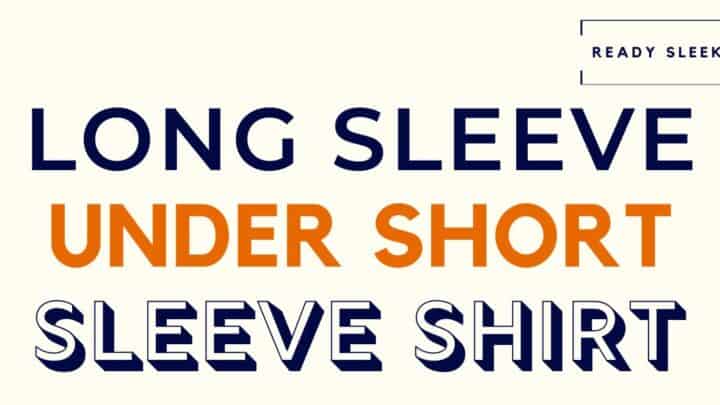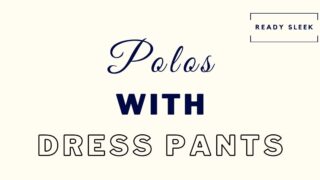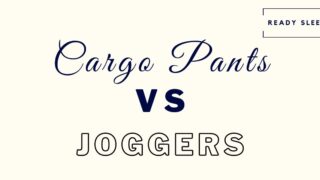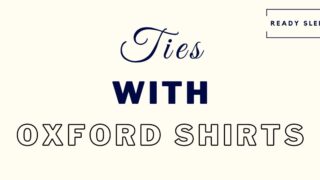Layering is a style that’s been around for a long time. So, can you wear a long sleeve shirt under a short sleeve shirt?
It’s possible to wear a short sleeve shirt over a long sleeve shirt. Consider the formality of the occasion and go for contrasting colors between the shirts. Ensure that your overlayer shirt is the right size to accommodate the underlayer – a size larger usually suits. Also, jeans work particularly well.
Although that’s the gist, there’s a lot more to it.
This post will go over seven essential tips to ensure you pull off the combination every time.
Let’s dig deeper.
1. Go For Contrasting Colors
Wearing a long sleeve shirt under a shirt sleeve shirt presents the perfect opportunity to throw some contrast into your outfit.
Because only the sleeves of the underlayer shirt will be visible, a dash of contrast greatly adds to the outfit’s aesthetic.
The best way to pull this look off is to ensure that the sleeves are the stand-out color compared to the shirt.
Having said this, it’s best to avoid bright, loud colors that are renowned for clashing with one another.
Colors that are contrasted but complementary work best, such as a sky blue underlayer with a navy overlayer.
The lightness of the sky blue contrasts well with the dark nature of navy; however, they still complement each other and, therefore, look great together.
A straightforward way to avoid any awkward color conflict is to ensure that one of the layers is a neutral color.
Here’s an example on Amazon:

Neutral colors that look particularly good as an overlayer or underlayer are white, black, grey, off-white, and olive green.
Due to their muted nature, they’re incredibly easy to combine with other colors.
A primary or secondary color would stand out compared to one of the mentioned neutral colors; however, they’d also complement one another.
It’s worth mentioning that two neutral colors can work together just as seamlessly if you wish to avoid any bold or bright colors.
Try to avoid any patterns with this outfit – block colors work best, by far.
2. Think About The Shirt Style
The term “shirt” is pretty vague. After all, there’s a plethora of shirt types and styles on the market – to the extent that knowing which one to choose can be challenging.
Only the sleeves of your underlayer shirt will be visible, so as long as it’s long-sleeved, the style of the shirt isn’t too important.
Just make sure your underlayer long-sleeve shirt doesn’t have a collar, as this will look awkward with the overlayer shirt.
On the other hand, the entirety of the overlayer is visible, and this, therefore, is where things can get confusing.
The best short sleeve shirts to wear as an overlayer are simply standard T-shirts or short sleeve button-ups.
These garments keep it simple and let the contrasting colors do the proverbial talking.
T-shirts are incredibly straightforward to wear with this 90s-esque outfit as there’s minimal variation – color and size being the only factors.
If going for a short sleeve button-up, however, there are more elements to consider.
One of the more important of these additional elements is whether or not you leave the buttons undone or do them up.
Leaving the buttons of your button-up shirt undone is much more suitable over a long sleeve shirt – if you do up the buttons, it can create a formality mismatch.
This is because, typically, button-up shirts are more suited to situations leaning towards formal rather than casual.
Another factor to consider if going for a button-up shirt as an overlayer is its collar.
While it’s a subtle detail, there are many different collar types when it comes to button-up shirts.
In truth, the collar type isn’t a hugely important factor; however, it’s best to avoid formal collars, such as the point collar.
Button-down collars work well, as the extra buttons add to the casual nature of the outfit.
Collarless button-up shirts can look great, too, so consider wearing one as your overlayer.
3. Consider Formality Of The Occasion
Wearing a long sleeve shirt under a short sleeve shirt is incredibly casual. So much so that it should always be avoided on any occasion with even a hint of formality.
It simply isn’t appropriate for anything other than casual situations, as, in formal situations, layering is only really appropriate with a blazer, suit, or – in some circumstances – a V-neck.
Although the outfit may not be suitable for formal or even semi-formal scenarios, it works perfectly when going to the movies or hanging out with friends, for example.
One of the primary reasons this isn’t appropriate isn’t solely related to the type of clothing, but the best colors for this ensemble, too.
As mentioned, contrast looks incredibly good with a long sleeve shirt under a short sleeve shirt.
Generally, in formal situations, extra contrast (other than the classic dark suit/blazer-white shirt combination) should be avoided.
Here’s another example of a truly casual color combination on Amazon:

4. Choose A Larger Overlayer
One of the biggest problems with layering items unconventionally is the size disparity.
For example, if you’re a size medium and you attempt to wear a medium underlayer and overlayer, it will likely lead to tightness and feeling uncomfortable.
This is even the case when your long sleeve shirt underlayer is slim-fit and sits close to your skin.
The thing is, a long sleeve shirt is primarily worn as a single layer and designed as such.
Therefore, it can add a surprising amount of bulk to your stature, even if – as mentioned – it is slim-fit.
The most effective solution to this is going for a shirt that is considerably larger and roomier than your underlayer shirt.
Alternatively, consider sizing up your outer layer short sleeve shirt. For example, if you’re usually a medium, go for a size large outerlayer shirt.
Another benefit of choosing a larger-sized shirt than usual is that, with this outfit, oversized garments can look great and contribute to the aesthetic.
5. Slim-Fit Long Sleeve Shirts Work Best
To further ensure this outfit isn’t uncomfortable and doesn’t feel overly tight on your body, consider choosing a slim-fit long sleeve shirt.
By going for a slim-fit long sleeve shirt underlayer, you have more flexibility regarding the size of your overlayer shirt.
Try to make sure your slim-fit shirt is as slim as you can get – without it being uncomfortable or obviously tight.
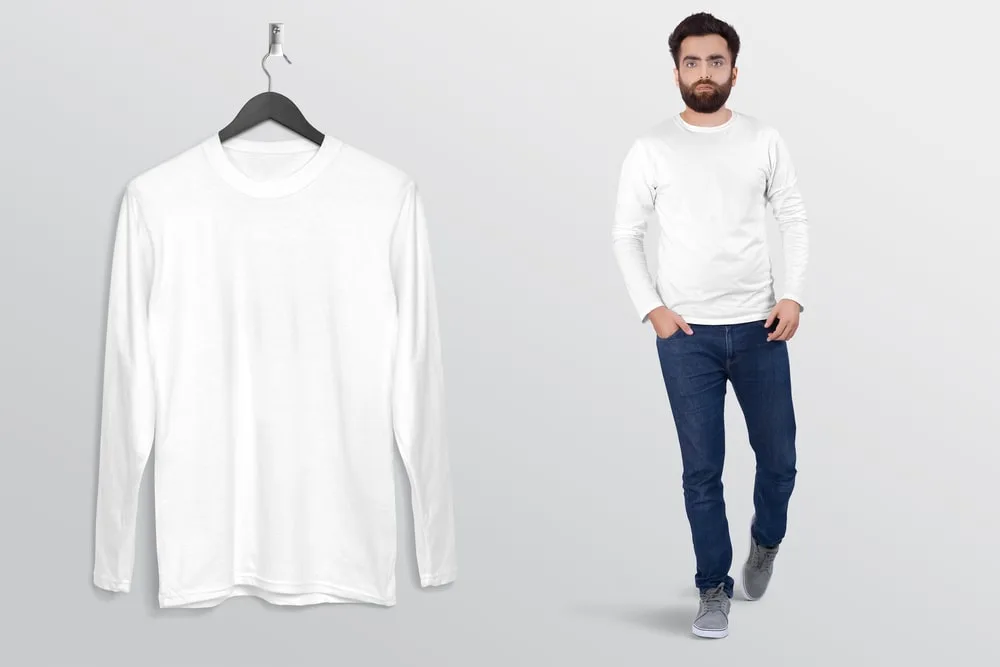
This will make sure that your short sleeve shirt overlayer fits well and comfortably when putting it on.
A slim-fit shirt may not be necessary: it entirely depends on how large and roomy your overlayer short sleeve shirt is.
6. Double-Layered Shirts Are An Option
They are becoming more and more unusual; however, they are still available if you know where to look.
Double-layered shirts are pretty much a 2-in-1 solution if you don’t want to wear two different shirts but still wish to achieve the layered look.
They look exactly the same as wearing this outfit but are only one garment.
A double-layered shirt is simply a T-shirt with different-colored long sleeves sewn onto the end.
Going for a double-layered T-shirt also means you don’t have to think too much about picking the right complementary colors, as they’re already done for you.
Furthermore, they mean you can spare some room in your wardrobe, and don’t have to purchase two different garments – one of which may also be too oversized to wear alone.
Wearing a double-layered T-shirt is also more comfortable than layering two different garments.
7. Jeans Look Great
Denim is the epitome of casual. The casual nature of a long sleeve shirt under a short sleeve shirt means that the outfit goes fantastically with jeans.
Jeans are incredibly versatile when it comes to casualwear. This outfit is very casual, so, naturally, jeans work fantastically with it.
There are so many different types of jeans on the market, and, in all honesty, the variety you pick with this outfit doesn’t really matter.
The only thing to steer clear of is skinny jeans, as they will contrast too much with the oversized nature of the outerlayer short sleeve shirt.
This can look disproportionate to your body and doesn’t create a particularly smooth transition.
However, this doesn’t mean the only acceptable option is baggy jeans – most jeans will work, with the exception of skinny jeans.

